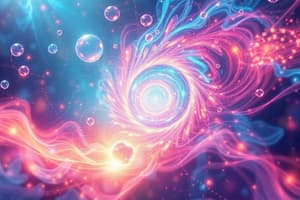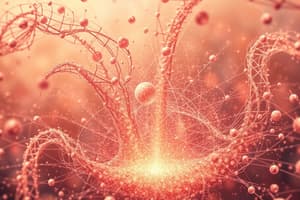Podcast
Questions and Answers
What is the primary characteristic of solids?
What is the primary characteristic of solids?
- Particles move freely in all directions
- Definite volume but no definite shape
- No definite volume
- Definite volume and definite shape (correct)
Gases have a definite shape and a definite volume.
Gases have a definite shape and a definite volume.
False (B)
What occurs during the process of vaporization?
What occurs during the process of vaporization?
Liquid to gas
The average kinetic energy of a substance's particles is measured as its __________.
The average kinetic energy of a substance's particles is measured as its __________.
Match the following phases of matter with their characteristics:
Match the following phases of matter with their characteristics:
What term describes the energy required to change a substance from solid to liquid?
What term describes the energy required to change a substance from solid to liquid?
The melting point is the temperature at which a solid starts to become a liquid.
The melting point is the temperature at which a solid starts to become a liquid.
What happens to the particles during the freezing process?
What happens to the particles during the freezing process?
Flashcards
Thermal Energy
Thermal Energy
The total energy of a material's particles, including both kinetic energy (energy of motion) and potential energy (stored energy).
Temperature
Temperature
A measure of the average kinetic energy of the particles making up a substance. It tells us how hot or cold something is.
Melting
Melting
The process where a solid changes into a liquid due to an increase in thermal energy, causing particles to move faster and break free from their fixed positions.
Melting Point (MP)
Melting Point (MP)
Signup and view all the flashcards
Freezing
Freezing
Signup and view all the flashcards
Freezing Point (FP)
Freezing Point (FP)
Signup and view all the flashcards
Vaporization
Vaporization
Signup and view all the flashcards
Condensation
Condensation
Signup and view all the flashcards
Study Notes
Solids, Liquids & Gases - Section 1
- Kinetic Theory: All matter is composed of tiny, moving particles. These particles are in constant random motion, colliding with each other and the container walls. The energy lost during collisions is insignificant.
Particle Arrangement in Phases of Matter
- Solids: Particles are tightly packed in a fixed arrangement. Particles vibrate but do not move.
- Liquids: Particles are close together but with no distinct arrangement. Particles can move and slide around each other.
- Gases: Particles are free-floating with no distinct arrangement. Particles move and collide with each other.
Properties of Solids, Liquids, and Gases
- Solids: Definite volume and definite shape. Particles are in a crystalline fashion.
- Liquids: Definite volume, no definite shape. Particles flow around each other, influenced by gravity.
- Gases: No definite volume, no definite shape. Particles constantly try to escape their container.
Thermal Energy
- Thermal Energy: The total energy of a material's particles. This includes both kinetic energy (energy of motion) and potential energy (stored energy).
- Temperature: A measure of the average kinetic energy of the particles in a substance. It indicates how hot or cold something is.
Changes of State (Phase Changes)
- Melting: Solid → Liquid. The solid starts to become a liquid at the melting point. Energy is required for particle movement to increase.
- Freezing: Liquid → Solid. The liquid starts to become a solid at the freezing point. The average kinetic energy decreases, and particles become fixed in position.
- Vaporization: Liquid → Gas. Particles in a liquid gain enough energy to escape into a gas phase.
- Evaporation: Occurs slowly at the liquid surface.
- Boiling: Occurs rapidly throughout a liquid.
- Condensation: Gas → Liquid. Gas particles lose energy, changing from a gas to a liquid. This is the opposite of vaporization.
- Sublimation: Solid → Gas. A solid changes directly to gas without becoming a liquid. An example is dry ice.
Melting/Freezing
- Melting Point (MP): The point at which a solid turns into a liquid.
- Heat of Fusion: The energy required to change a substance from a solid to a liquid at its melting point.
- Freezing Point (FP): The point at which a liquid turns into a solid.
Vaporization/Condensation
- Heat of Vaporization: The amount of energy required to vaporize a liquid.
Sublimation
- Sublimation: The direct change of a solid to a gas without passing through the liquid phase. Dry ice is an example.
Plasma
- Plasma: Matter beyond the gas phase. Plasma particles have enough energy to overcome attractive forces both between particles and within atoms. Plasma makes up most of matter between stars and in stars themselves.
Amorphous Solids
- Amorphous Solids: Some solids don't have a crystalline structure; their shape can change without losing solid properties. Examples include wax, tar, and silly putty.
Studying That Suits You
Use AI to generate personalized quizzes and flashcards to suit your learning preferences.




